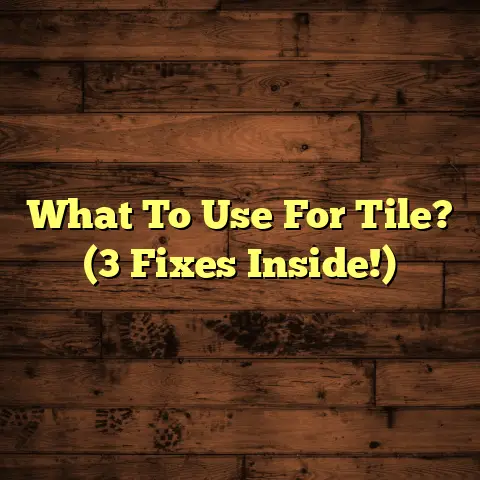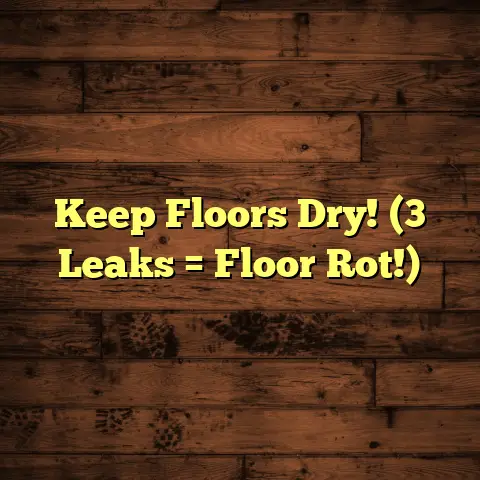Epoxy Garage Floor Cost? (5 Minute Estimate!)
As a flooring contractor, I’ve seen countless garages that have suffered from years of abuse.
Oil spills, chemical exposure, heavy tools dropping – it all takes a toll.
Traditional garage floors just can’t stand up to the wear and tear. You end up with cracks, stains, and a generally unappealing space.
That’s where epoxy flooring comes in.
It’s not just about making your garage look good. It’s about investing in a durable, long-lasting surface that can handle anything you throw at it.
Plus, it seriously upgrades the whole look of your garage. So, how much does this magic solution cost? Let’s dive in!
Section 1: Understanding Epoxy Flooring
So, what exactly is epoxy flooring?
Think of it as a super-tough, super-shiny shield for your concrete. It’s made of two main components: a resin and a hardener.
When these two are mixed, they create a chemical reaction that results in a rigid, durable, and chemical-resistant surface. Pretty cool, right?
Now, there are different types of epoxy coatings, each with its own unique properties and uses.
-
Self-Leveling Epoxy: This is what you want if your garage floor is uneven or has cracks. It creates a smooth, seamless surface.
-
Mortar Epoxy: The heavy-duty option. It’s mixed with sand or quartz to create an extremely durable floor, perfect for high-traffic areas or garages that see a lot of heavy use.
-
Flake Epoxy: This is where you can get creative! Colored flakes are added to the epoxy to create a decorative, slip-resistant finish.
-
Metallic Epoxy: Want a floor that looks like liquid metal? Metallic epoxy uses metallic pigments to create a stunning, one-of-a-kind look.
Okay, but why choose epoxy over other flooring options?
Well, let’s talk benefits:
-
Durability: Epoxy floors are incredibly resistant to impact, abrasion, and chemicals. They can handle just about anything you throw at them (or drop on them!).
-
Chemical Resistance: Oil, gasoline, brake fluid – epoxy laughs in the face of these common garage spills.
-
Ease of Maintenance: Cleaning is a breeze. Just sweep or mop, and you’re done.
-
Seamless Look: No grout lines to worry about! Epoxy creates a smooth, continuous surface that’s both beautiful and hygienic.
In my experience, the seamless look of epoxy flooring is a huge selling point for many homeowners.
It instantly elevates the look of the garage and makes it feel more like an extension of the house.
Section 2: Factors Influencing Epoxy Garage Floor Cost
Alright, let’s get down to the nitty-gritty: cost.
There are several factors that will influence how much you’ll pay for an epoxy garage floor.
Let’s break them down:
-
Material Costs:
This is where the type of epoxy you choose comes into play. Self-leveling epoxy, for example, tends to be more expensive than a basic solid epoxy.
The quality of the epoxy also matters.
Cheaper epoxies may not be as durable or resistant to chemicals, so you might end up having to replace them sooner.
As a general guide, you can expect to pay anywhere from $3 to $12 per square foot for the epoxy materials themselves.
Of course, this can vary depending on the brand, type, and any additives you choose.
-
Labor Costs:
Unless you’re a DIY expert, you’ll probably want to hire a professional to install your epoxy floor.
Labor rates can vary depending on your location, the complexity of the job, and the contractor’s experience.
I’ve seen labor costs range from $2 to $7 per square foot.
More experienced contractors might charge more, but they’ll also likely do a better job and ensure the floor lasts longer.
-
Preparation Costs:
This is a crucial step that many homeowners overlook. Before you can apply epoxy, you need to properly prepare the existing concrete floor.
This includes:
- Cleaning: Removing any oil, grease, or other contaminants.
- Repairing: Filling any cracks or holes.
- Grinding: Etching the surface to create a better bond for the epoxy.
Preparation can add $1 to $3 per square foot to the overall cost.
Trust me, don’t skimp on this step! Proper preparation is essential for a long-lasting epoxy floor.
-
Size of the Garage:
This one’s pretty obvious, but the larger your garage, the more you’ll pay for materials and labor.
Here are some examples:
- 1-Car Garage (200-250 sq ft): Expect to pay between $800 and $3,750.
- 2-Car Garage (400-500 sq ft): Expect to pay between $1,600 and $7,500.
- 3-Car Garage (600-750 sq ft): Expect to pay between $2,400 and $11,250.
These are just estimates, of course. Your actual cost could be higher or lower depending on the factors we’ve already discussed.
-
Design Choices:
Want to add some flair to your epoxy floor?
Decorative options like color flakes or metallic finishes can add to the cost.
Color flakes typically add $0.50 to $2 per square foot, while metallic finishes can add $2 to $5 per square foot.
Special features like logos or custom designs will also increase the price.
I always tell my clients to consider their budget before getting carried away with design choices.
It’s easy to get caught up in the possibilities, but it’s important to stay realistic about what you can afford.
Section 3: Quick Estimation Techniques
Okay, so you want to get a rough estimate of how much an epoxy garage floor will cost without spending hours researching? I got you covered.
Here’s a simple, five-minute estimation technique:
Step 1: Measure Your Garage
Grab a tape measure and determine the length and width of your garage. Multiply these two numbers to get the square footage.
Step 2: Choose Your Epoxy Type
Decide what type of epoxy you want (basic, flake, metallic, etc.). This will help you estimate material costs.
Step 3: Estimate Material Costs
Based on the epoxy type you chose, estimate the material cost per square foot. Use the ranges I mentioned earlier ($3-$12 per sq ft).
Step 4: Estimate Labor Costs
Estimate the labor cost per square foot. Again, use the range I mentioned earlier ($2-$7 per sq ft).
Step 5: Calculate the Total Cost
Use this simple formula:
(Square Footage x Material Cost per Sq Ft) +
(Square Footage x Labor Cost per Sq Ft) +
(Square Footage x Preparation Cost per Sq Ft) =
Total Estimated Cost
Let’s do a few examples:
Example 1: 2-Car Garage (400 sq ft), Basic Epoxy
- Material Cost: $5 per sq ft
- Labor Cost: $4 per sq ft
- Preparation Cost: $2 per sq ft
(400 x $5) + (400 x $4) + (400 x $2) = $4,400
Example 2: 1-Car Garage (250 sq ft), Flake Epoxy
- Material Cost: $8 per sq ft
- Labor Cost: $5 per sq ft
- Preparation Cost: $2 per sq ft
(250 x $8) + (250 x $5) + (250 x $2) = $3,750
Example 3: 3-Car Garage (600 sq ft), Metallic Epoxy
- Material Cost: $10 per sq ft
- Labor Cost: $6 per sq ft
- Preparation Cost: $2 per sq ft
(600 x $10) + (600 x $6) + (600 x $2) = $10,800
Remember, these are just ballpark figures.
To get a more accurate estimate, I recommend getting quotes from several different contractors.
This will give you a better idea of the going rates in your area and help you find the best deal.
Section 4: Long-term Cost Considerations
Okay, so you know the initial cost of an epoxy garage floor. But what about the long-term?
Here’s the good news: epoxy flooring can actually save you money in the long run.
-
Maintenance Costs:
Epoxy floors are incredibly easy to maintain. Unlike traditional concrete floors, they don’t require sealing or waxing.
Just sweep or mop regularly, and you’re good to go.
This can save you a significant amount of money on cleaning supplies and maintenance services over time.
-
Durability:
Epoxy floors are built to last. They can withstand heavy traffic, impact, and chemical spills without showing signs of wear and tear.
This means you won’t have to replace your flooring as often as you would with other options like concrete paint or floor tiles.
-
Property Value:
A well-maintained epoxy garage floor can actually increase the value of your home.
It’s a feature that many homebuyers appreciate, especially those who are looking for a durable and low-maintenance garage space.
How does epoxy stack up against other options?
- Concrete Paint: Cheaper upfront, but it chips, peels, and fades quickly. You’ll likely have to repaint every year or two.
- Floor Tiles: More durable than paint, but they can crack, and the grout lines can be difficult to clean.
- Epoxy: Higher upfront cost, but it lasts much longer, requires less maintenance, and looks better.
Of course, epoxy floors aren’t completely immune to damage. Over time, they may require re-coating or repairs.
- Re-coating: Depending on the amount of traffic and wear, you may need to re-coat your epoxy floor every 5-10 years. This involves applying a new topcoat to refresh the finish.
- Repairs: If your epoxy floor is damaged by impact or chemicals, you may need to repair it. This typically involves patching the damaged area and applying a new layer of epoxy.
These potential issues can add to the overall cost of your epoxy floor over time.
However, the long-term savings on maintenance and replacement costs usually outweigh these expenses.
Section 5: Real-Life Examples and Case Studies
Alright, enough theory! Let’s look at some real-life examples of homeowners who have installed epoxy garage floors.
Case Study 1: The Smith Family
The Smiths had a two-car garage with a cracked and stained concrete floor. They were tired of looking at it and wanted to upgrade their garage space.
They decided to install a flake epoxy floor.
- Initial Cost: $4,800
- Experience: The installation process took three days, including surface preparation.
- Satisfaction: The Smiths were thrilled with the results. Their garage floor looked brand new, and they loved the added durability and easy maintenance.
Before & After (Described): The “before” photo shows a dull, cracked concrete floor with oil stains.
The “after” photo shows a vibrant flake epoxy floor with a glossy finish.
Testimonial: “We were hesitant to spend the money on epoxy, but it was the best decision we ever made. Our garage looks amazing, and we don’t have to worry about spills or stains anymore.”
Case Study 2: The Jones Family
The Joneses had a one-car garage that they used as a workshop. They needed a durable floor that could withstand heavy tools and chemical spills.
They opted for a mortar epoxy floor.
- Initial Cost: $3,200
- Experience: The installation was a bit more involved due to the extra thickness of the mortar epoxy.
- Satisfaction: The Joneses were impressed with the floor’s strength and resistance to damage.
Before & After (Described): The “before” photo shows a worn-out concrete floor with scratches and dents. The “after” photo shows a smooth, seamless mortar epoxy floor that looks incredibly tough.
Testimonial: “We put our garage floor through a lot of abuse, but the epoxy has held up perfectly. It’s the toughest floor I’ve ever seen.”
Case Study 3: The Davis Family
The Davis family wanted to create a unique and stylish garage space. They chose a metallic epoxy floor.
- Initial Cost: $6,000
- Experience: The installation required a skilled contractor who was experienced in working with metallic epoxy.
- Satisfaction: The Davises were blown away by the floor’s stunning appearance. It looked like liquid metal and added a touch of luxury to their garage.
Before & After (Described): The “before” photo shows a plain concrete floor. The “after” photo shows a mesmerizing metallic epoxy floor with a shimmering, three-dimensional effect.
Testimonial: “Our garage floor is the envy of the neighborhood! It’s a work of art.”
These case studies demonstrate that epoxy garage floors can be a worthwhile investment for homeowners who are looking for a durable, attractive, and long-lasting flooring solution.
Conclusion
So, there you have it! A comprehensive guide to understanding the costs associated with installing an epoxy garage floor.
We’ve covered everything from the different types of epoxy coatings to the factors that influence the price and the long-term cost considerations.
Remember, investing in an epoxy floor is not just about aesthetics.
It’s about protecting your concrete from wear and tear, creating a durable and low-maintenance surface, and potentially increasing the value of your home.
I encourage you to consider your own garage needs and how an epoxy floor could fit into your renovations or home improvements.
Do your research, get quotes from multiple contractors, and choose the option that best fits your budget and lifestyle.
With a little planning and effort, you can transform your garage into a space that you’re proud of.
And who knows, maybe you’ll even become the envy of the neighborhood! Good luck with your project!





